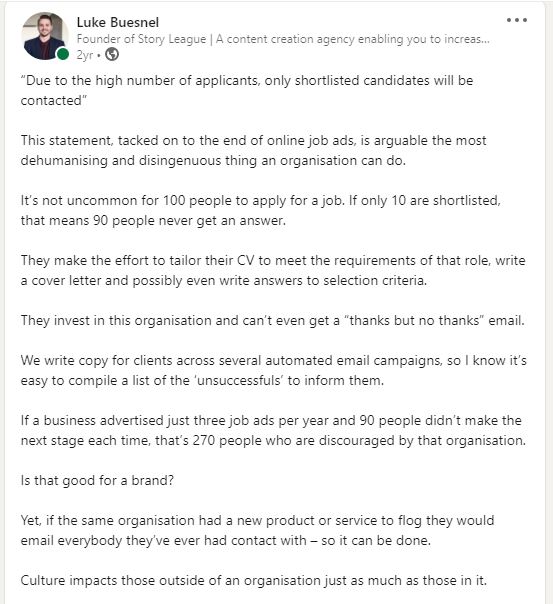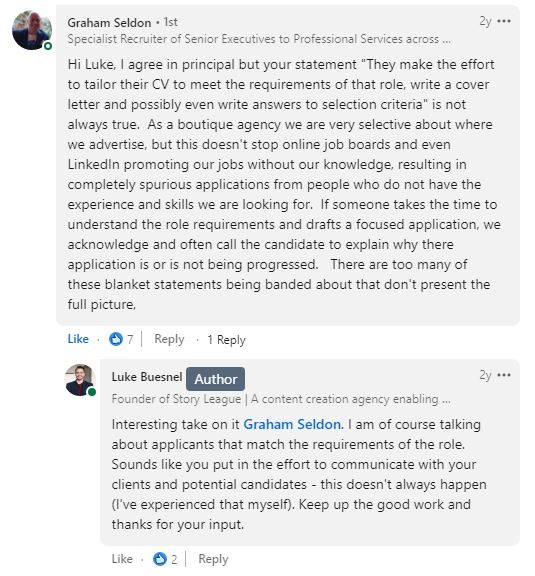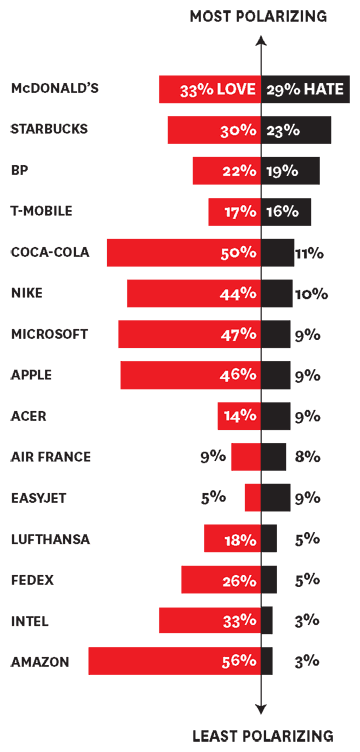If there’s one thing that gets online users talking, it’s polarising content. Whether the topic is about politics or football, every one of us has a side that we support and seeing content made against it can be triggering.
That’s the effect of polarisation. By definition, it is the extreme difference of opinion and interest between two or more groups of people. It elicits an immediate response and brings up mixed reviews.
When applied to content marketing, it refers to the event when the business chooses a stance against something and creates content based on that belief. It’s designed to relate to a particular group of customers and not to the general population, so not everyone will receive the information positively.
Below is a screenshot of a post on LinkedIn from Story League founder, Luke Buesnel, that’s polarising in nature. It was used to highlight something he’s passionate about but also reference that we have a solution for it (i.e. writing automated emails).
The comments he received varied greatly, from those who agreed and appreciated his message to those who downright disagreed and disliked what he had to say about it.


At first glance, it can be nerve-wracking to choose a side on a hot issue, seeing how it can turn off a group of potential customers from buying your products. You’ll find, however, that creating polarising content can draw attention to your small business and create a loyal following of people who genuinely support the brand and its messaging. This consequently drives traffic back to your website, increases brand awareness and widens your customer reach.
Having a stance can also make you stand out from competitors. Businesses that remain indifferent don’t leave a lasting mark and are often forgotten when people go about their daily activities. Companies that stand for something important, on the other hand, create buzz around their brand, leading to better brand recall and recognition.
It’s good to remember that polarising content is not designed to alienate other customer groups, rather it’s created to better serve the business’ specific target market with content that they can relate to and get behind.
Creating polarising content can be tricky, especially if you don’t know where to begin. The key here is to understand that polarising content starts with determining the direction of your content strategy. To do that, you’ll need to know how liked or disliked your brand is with customers.
How to measure the polarisation of your brand
Businesses can use brand dispersion to measure their polarisation. This allows you to gauge what stance to take and understand your targeted customer group’s preferences better.
The brand dispersion metric provides numerical values to how well-liked or disliked your brand is to customers. The more widely dispersed the percentages are, the more polarising your brand is.
The graph below is an example of how this measurement works. In this YouGov BrandIndex study reported by the Harvard Business Review, McDonald’s is ranked the most polarising brand with 33% love and 29% hate ratings. Amazon is the least polarising with its love percentage significantly exceeding its hate rating.

To get these measurements, businesses can use either of these two methods:
- Conduct a customer survey. Businesses can select a group of customers within a day to rate from one to ten how much they like or dislike the brand. The averaged ratings can then be converted into percentages to gauge the business’ level of polarisation.
- Calculate it through standard deviation. Through a complex statistical formula called standard deviation, companies can determine how polarising their brand is to customers. By inputting their gathered data and applying the algorithm, businesses are able to calculate their polarisation ratings. The higher their standard deviation values are, the more polarising their brand is to customers.
Determining your business’ polarisation status allows you to target a specific customer group and gives you direction on the content you need to be making for them.
Benefits of having polarising content for your business
It might sound crazy but choosing a stance on an important issue can be a good thing. It incites a thought-provoking conversation with your customers. The more they talk about your business, the better they recall your brand and the higher the chances are to land a potential sale.
It even works in instances when the number of people who hate your brand outweighs those who love it. In fact, there are companies that boosted their sales by increasing the number of product haters. Europe’s low-cost air carrier Ryanair, for example, addressed their customers’ frustration over the airlines’ cost-cutting methods by further embracing its business image as a functional and affordable airline service and releasing more content about it.
“It (Ryanair) is absolutely not about becoming loved [by customers],” Ryanair Head of Marketing and Customer Communications Kenny Jacobs told The Journal about their 2017 campaign.
You can also use social media platforms like Facebook, Instagram or Twitter to further express your business’ opinion on a major issue. Remember, social media gives haters a ready outlet for broadcasting their dislike, which will grab the attention of people who agree with your brand’s stance and get conversations going.
Here are some of the advantages that are possible with the right polarising content:
1. Increased brand recognition
Having your brand take a stance on a relevant issue will draw people into your content and capture their attention. Hot topics elicit an immediate reaction and create conversations with customers.
While this response may vary from being positive to negative, either way, makes your content memorable. The more customers talk about your brand, the better they’ll remember your business and share their discussions with friends and family.
This also sets your business apart from competitors who are indifferent. It shows customers that you care about something that’s important to them, which encourages them to buy from your business rather than support competing brands that remain neutral on important issues.
2. Improved strategy planning
Understanding the reasons people love or hate your brand will give you choices on where to focus your marketing efforts; do you agree with the lovers or poke the haters to get a bigger reaction?
Knowing the reasons behind your audience’s reactions provides you with a clear indication of why your customers feel the way they do, allowing you to support or contradict their opinions through your content. You also get the ability to create content around the specific topics that are engaging, and interesting to them and side with your audience on their beliefs (or challenge them to change).
This detailed assessment of a specific target market group improves content strategy planning in your company and makes business goals and initiatives very customer-centric and customer-driven.
As well as developing engaging high-quality content around their needs, your customers will feel more acknowledged by your brand, enticing sales and brand loyalty. The more they feel that their needs are being met, the more likely they will want to continue buying your products or using your services.
3. Increased sales
Businesses that advocate a belief with a strong following are more than likely to get a group of customers who are willing to buy their products. Customers tend to choose brands with messages that they can relate to or identify with. By advocating a message that’s relevant to your target market, you encourage them to want to know more about your business, generating leads and potentially increasing sales in the process.
A good example of this result can be seen in Nike’s campaign with Colin Kaepernick. When Nike released the video and posters in support of Kaepernick’s move to first sit down (and then later kneel) during the U.S. national anthem, it garnered mixed reviews from customers. In the graph below from research company BAVSocial via the Campaign US website, you can see that the negative responses increased in value after their content was released, further reducing the level of indifference to the brand and creating a more polarised view of it.

Despite this change in percentages, Nike greatly benefited from their stance. According to The New York Times, the sporting goods brand received “record engagement” with customers. Its chief executive Mike Parker even commented, “We feel actually very good and are very proud of the work we’ve been doing. We know it resonated actually quite strongly with consumers.”
This campaign proves how polarising content can positively impact a brand’s image and spark interest in their specific customer group to purchase their products or use their services. Check out copywriting services for strategies on how to communicate with your marketplace.
How small businesses can start creating polarising content
To get this right, you need to use your smarts. The last thing you want is to create negative noise just for the sake of it. The aim of polarising content is to identify your customer group and serve them and their interests in a heart-to-heart gesture, not to offend someone just to get a few likes.
It’s important to utilise polarising content correctly to enjoy the rewards it has to offer and create a marketing campaign that’s relevant and memorable to your targeted customers.
This post is an example of using polarising content against social media influencers. We don’t like them, nor does our ideal customer base. So we’ve played on this in our social media campaigns which was well received by the people we are targeting.
https://www.instagram.com/p/CPZpgbxFB7A/
To make sure that you use polarising content to your advantage, it helps to follow these steps:
- Be prepared to say something unique. Choosing a relevant issue to stand behind is just the first step in content creation. Now, you need to be prepared to stand behind what you say. To get your message across it’s important to say something unique about the issue. This will set your business apart from competitors who may be doing the same thing and offer new and valuable information to customers. It’ll also make it more memorable for people seeing your content, especially since it’s different content from what they’ve already seen.
- Continue doing extensive research. Most social issues develop over time, so it’s not enough to do preliminary research alone. You need to stay updated on developments which includes doing extensive research on the market and the groups affected by the issue. The worst thing you can do is release content for an issue that has long since passed.
- Develop a solid content strategy in line with your brand’s ideals. After collecting the necessary information and choosing a stance, it’s important to create a content strategy that underpins and supports your business’ wider marketing goals. Make sure that the cause you’re supporting is in line with your company’s ideals. Choosing an issue not related to your brand or industry will only confuse your customers and set off arguments that won’t result in gains for your business.
- Plan how to execute your strategy. Polarising content has the ability to drive a wedge into your existing market. By determining where the split will be you can capitalise by planning to address the sector you want a response from. Look for ways to show your support and relate with them so they can identify that you are on their side and part of the same team. One good way of doing this is by launching a provocative ad or blog expressing your stance on a social issue.
- Utilise relevant mediums. There are plenty of ways to communicate your message so look for the one that will be the best fit for your audience as well as your message. Use social media posts, blogs or videos to express your business’ stance and upload them to your website and other social pages that are relevant to your target market. This ensures that your message is getting across to your chosen customer group in a quick and timely manner.
Taking that extra step of determining your polarising measurement and using it to create additional material for your current content marketing plans, will put you one step ahead of your competitors and allow you to build a brand identity with your specific customer group and entice them to visit your website and check out your products.
In time, you’ll find that your targeted audience will become not just a loyal following of customers, but also brand patrons who are eager and excited to share news and updates about your business, inevitably pushing your small business to the next level.
Polarising content creates an instant impression. Through the right content creation process and platforms to release your message by leveraging the expertise of professional copywriting services, you’ll find that your content may do more than just incite change in your immediate community, it can also invite serious conversations with customers all over the world.

